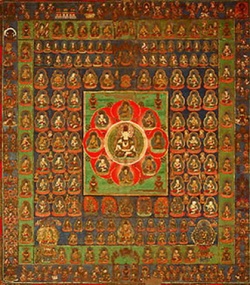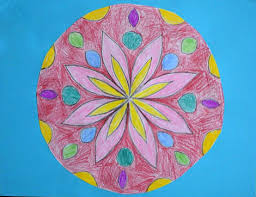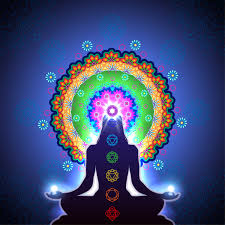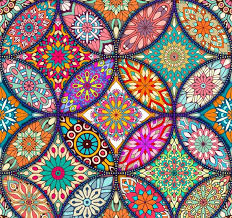Mandalas are found among the most ancient art forms created by human beings. Rock carvings found all over the world incorporate the circular form and its variations such as spirals, crosses, concentric circles. It is thought that they express worshipful awe of nature’s cycles and the mysteries of life and death. The alternation of day and night, the ever-changing moon, and the rhythms of the seasons are aptly expressed by circular designs.
The circle is the most natural form known to mankind. The Universe is made up of planets, stars, moons and the sun, all spherical in shape. The sun rises and sets in a never-ending circle; seasons pass in an annual circle. Trees, rocks and raindrops are circular, and most fruits and flowers are spherical. The cells and atoms that make up everything within the universe are circular.
The word “mandala” is Sanskrit for “circle.” According to mandala artist Charles Gilchrist, creator of “Sacred Geometry,” a wandering guru may have brought the first meditation mandalas to Tibet in about the eighth century. Mandalas have been found across the Far East, and Native Americans symbolism is based on the “sacred hoop.” Mandalas are considered to be of Eastern origin, but it would be difficult, if not impossible, to find any civilization without some awareness of the circle’s symbolism and potential for spiritual self-examination.

Mandalas have been used by Buddhists, Hindus, Tibetans and Native Americans in prayer, meditation and for healing. Buddhists make mandala sand paintings that are destroyed after they have served their purpose. Many Christian religions use the mandala without even realizing it. For example, Gothic cathedral rose windows, with their intricate designs, are clearly mandalas.
Today, mandalas are often used in therapy to represent the “wholeness” of the patient. Babies as young as one week old prefer to look at circles over other shapes, which indicates that humans have an inborn desire to look at circular shapes. When children learn to draw, the circle is the first shape they make after random scribbling. As adults, drawing a circle helps us reconnect with our childhood. Making a mandala can help people regain their sense of self and recognize their place in the world.

The mandala as art form continues today as well. The kaleidoscope is one of the simplest ways to experience mandala art. Some artists use recycled records and compact discs to form the basis of their mandalas, while others use clay, canvas, dinner plates or even fabric.
Watching or creating mandalas requires our ability to connect to our intuitive and intellectual self, to be able to simultaneously use the right and the left hemisphere of our brain. Mandalas help us in this procedure of connecting to ourselves, fine-tuning within.
Making yourself aware of your own feelings, intuitions and experience have primacy in the creation and receptive interpretation of mandalas.
Different Shapes in Mandalas:
Dot: everything is one, symbol of the unmanifested
Circle: wholeness, integrity, unity
Horizontal line: divides up from down, the earth and the sky. Maternal energy.
Vertical line: connection between worlds, energy. Divides right and left.
Cross: two lines meet and form a centre. Recognition.
Triangle with the vertex pointed upwards: aspiration, energies pointing upwards, in the direction of the spiritual sphere
Triangle with vertex pointed downwards: aspirations towards the earthly, material sphere
Hexagon, created from the above-mentioned triangles: unity spiritual and material aspirations
Square: our existence in the material world
Circle and square together: implementation of the spirit in the material
Octagon: harmony in human existence
Pentagon: human being brought to perfection
Heptagon: spiritual way
Circle divided to twelve parts: cycle of nature, wholeness
Swastika: Sun, energy, movement of the Universe
Spiral: cyclic movement of nature, dynamics. The two directions of the spiral symbolises the constructive and the destructive aspects
Different Colours in Mandalas:
Colours can be interpreted in many different ways:
- According to the colours of the chakras
- According to the seasons, natural forms
- According to the interpretation of different spiritual schools
- According to Feng-shui
You can experience what feelings are aroused in you by a specific colour – does it activate or relax you, does it vitalize or soothe you, does it raise a warm or cold sensation? You can read a lot about the effect that pure colours have on our chakras and – through the chakras – on our mood and even on the way our organs function. Selecting colours spontaneously (using the colours that are the most appealing to us) can lead us to find the colours that are important for us, the colours that heal and help us in harmonization. When ready, the mandalas we create can be interpreted, stared at in astonishment as many recognitions may be born.
Yellow: power, light, joy, this is the colour of the 3rd chakra
Orange: ample energy, heat, colour of the 2nd chakra
Red: fire, passion, colour of the 1st chakra
Violet: spiritual forces, colour of the 6th chakra
Blue: protection, tranquility, coldness, colour of the 5th chakra.
Green: peace, nature, colour of the 4th chakra
White: purity, unity, colour of the 7th chakra
Black: secret, darkness
Grey, just like brown, has several shades. They can either be cold or warm and they can be almost identical with one of the pure colours. They can be vivid or soft, can express boredom and sadness or, on the contrary, vitality and cheerfulness.


